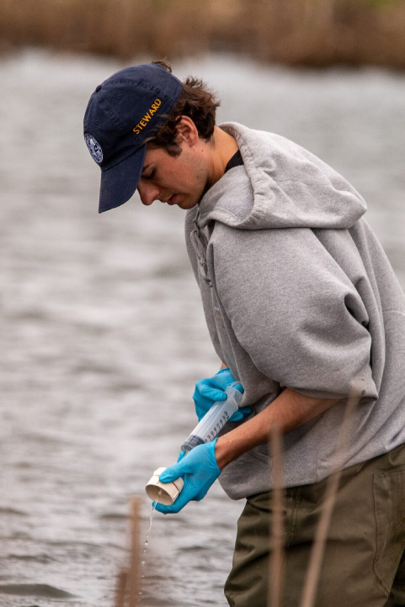A faster, better way to help ‘the cutest turtle in Ontario’

Bradley Squarek is working on a faster, less invasive and more cost-effective way to detect Blanding’s turtle occupancy of wetland areas, with potential benefits for conservation.
BY Caelan Beard
April 14, 2025
“I spend a lot of time outside these days.”
Biology graduate student Bradley Squarek loves hiking, sports, and generally “being a naturalist” – taking photos of birds and insects, and logging sightings on citizen science platforms like eBird.
Being close to nature, including Dundas Marsh and Cootes Paradise, has definitely enriched his McMaster experience, Squarek said. “It’s so, so wonderful to have that near campus.”
In his time at McMaster, where he also completed his undergraduate degree, he’s worked as a teaching assistant, an undergraduate researcher with the student-run Climate Action Consultancy, and a bilingual nature interpreter for the Royal Botanical Gardens.
Summers of field work in the Georgian Bay Area, including a stint with the McMaster Ecohydrology Lab, introduced him to the Blanding’s turtle.
These opportunities led him to focus his master’s on the Blanding’s turtle, under the supervision of Pat Chow-Fraser. He’s working on a faster, less invasive and more cost-effective way to detect Blanding’s turtle occupancy in wetlands, with potential benefits for conservation.
The smily-est turtle around
As far as turtles go, this one is pretty special: They’re charismatic, shy, and gentle, with a bright yellow throat and a mouth shape that looks like they’re perpetually smiling.
“It’s probably the cutest turtle in Ontario,” Squarek said.
They can live for over 80 years and spend their time in both aquatic and terrestrial habitat, sometimes making long-distance movements up to six kilometres.
They’re also, unfortunately, a threatened species in Ontario and endangered in Canada.
One of the first steps to ensuring their conservation, Squarek said, is finding out where the turtles are located.
Knowing where they are can inform conservation actions, such as protecting land and habitat, raising awareness and educating locals about a new population, and seasonal public-use closures of critical areas.
Blanding’s turtles are also an umbrella species, Squarek notes. That means that if we protect their habitat (wetlands and the areas around them), all the other species using the same habitat will benefit as well.
Currently, the way that researchers detect Blanding’s turtles in a wetland is by either wading in and scanning the area with binoculars for a visual encounter survey, or setting up traps and checking on them periodically. Neither method is ideal: Visual searches are time consuming and costly, and traps can cause occasional animal mortality.
Squarek’s project is introducing a relatively new technique, called environmental DNA, and putting it up against these two traditional methods to detect Blanding’s turtles.
How does environmental DNA work?
“All species release cells,” Squarek said. “In those cells, in those particles, there’s DNA. And so pretty much everywhere on Earth you could imagine – in the air, in the water, in the soil – there’s cellular residue from organisms.”
This DNA that species shed into the environment is called “environmental DNA,” or eDNA. Sampling water or soil for eDNA can provide insights about what species are present, or have recently been, in an area.
Squarek collects water samples from wetlands, filtering it and bringing it back to the lab, where he extracts and purifies the DNA, analyzing it to detect even very small amounts of turtle DNA that are present in the sample.

Last summer, Squarek put the eDNA method to the test, completing fieldwork in Illinois and Ontario and comparing it to results from visual encounters and trapping surveys done by partner organizations.
In both cases, the eDNA method was found to be just as effective as traditional methods at detecting the Blanding’s turtle in wetlands.
Further research projects could even explore using eDNA to estimate how many turtles are in an area; some studies have found eDNA can be used to accurately estimate fish populations.
Benefits to broader conservation efforts
This new method of using eDNA could mean that researchers don’t have to shell out quite as much time or money to figure out whether a wetland is home to Blanding’s turtles.
That can benefit broader conservation efforts, Squarek said, as it frees up resources for other projects.
“Conservation practitioners, or anyone doing field research, they have a lot on their plate,” Squarek said. “It’s not just turtles they’re interested in…. they also need to do all kinds of different surveys during the day, for birds, insects, mammals, you name it.”
“It’s not just about protecting our species of interest and knowing where they are, but freeing up some time to get all kinds of conservation work done too,” he said.
And if you have a little free time? Squarek recommends spending it in Cootes Paradise.
“We’re next to some of the most abundant biodiversity in Canada, right next door to the Carolinian forest,” Squarek said. “It’s a really special place.”
He encourages anyone who’s starting their undergrad to “just make a point of getting out there at least once a week, once a month,” he said.
“The way that we can get people more interested or more involved with doing good things for our planet is just to actually get out and experience what a beautiful area of our planet is like.”


